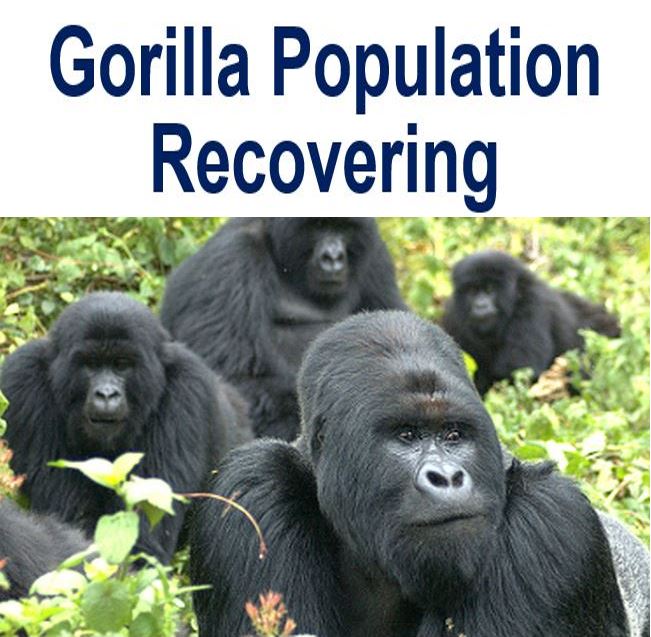The number of mountain gorillas in the wild has increased from just 253 in 1981 to about 480 in the Virunga volcanic mountain range on the borders of Uganda, the Democratic Republic of Congo and Rwanda, a new study has found.
Surprisingly, inbreeding appears to have removed some harmful genetic variations from the mountain gorilla population.
The first project to sequence whole genomes from mountain gorillas has given researchers and conservationists a deeper understanding of the impact of population decline on these critically endangered primates.

Even though mountain gorillas are extensively inbred and at risk of becoming extinct, a study published in the academic journal Science (citation below) found there is more to be optimistic about in their genomes than expected.
First in-depth, whole-genome analysis
Dr Chris Tyler-Smith, corresponding author from the Wellcome Trust Sanger Institute, said:
“Mountain gorillas are among the most intensively studied primates in the wild, but this is the first in-depth, whole-genome analysis.”
“Three years on from sequencing the gorilla reference genome, we can now compare the genomes of all gorilla populations, including the critically endangered mountain gorilla, and begin to understand their similarities and differences, and the genetic impact of inbreeding.”
The authors say the wild mountain gorilla population is recovering thanks to efforts led by the Rwanda Development Board, as well as several conservation organizations including the Gorilla Doctors (a partnership between the UC Davis Wildlife Health Center and the non-profit Mountain Gorilla Veterinary Project), and tourists keen to see gorillas thrive again.
Scientists interested to determine how such a small gene pool would affect the mountain gorillas were amazed to discover that several harmful genetic variations had been removed from the population through inbreeding.
They also found that the apes are genetically adapting to surviving in tiny populations.
Co-author, Dr Aylwyn Scally, who works in the Department of Genetics at the University of Cambridge, said:
“This new understanding of genetic diversity and demographic history among gorilla populations provides us with valuable insight into how apes and humans, their closely related cousins, adapt genetically to living in small populations.”
“In these data we can observe the process by which genomes are purged of severely deleterious mutations by a small population size.”
Researchers have been able to sequence the whole genomes of seven mountain gorillas after collecting blood samples over several years, thanks to Gorilla Doctors (which treats wild gorillas injured by traps), the Institut Congolese pour la Conservation du Nature and the Rwanda Development Board.
Scientists had previously only had access to poor-quality DNA from hair and faecal (US: fecal) samples at a handful of genetic loci.
Researchers were now able to see that these mountain gorillas, along with their closely related neighbours, the eastern lowland gorillas, were up to three times less genetically diverse than gorillas from bigger groups in western regions of central Africa.
Surprising benefits of inbreeding
While there is some concern that this reduced level of genetic diversity may make the animals more vulnerable to environmental change and to disease, including cross-infections of human viruses, in some ways the inbreeding has been genetically beneficial.
The researchers have found fewer harmful loss-of-function variants among the mountain gorillas than in the more numerous western gorilla populations. These variants stop genes from working and can trigger serious and sometimes fatal health conditions.
After analyzing the variations in each genome, the scientists have discovered that mountain gorillas have existed in small numbers for several thousands of years.
Using recently-developed methods, they have been able to find out how the size of population has altered over the past million years.
Their calculations estimate that mountain gorilla populations have averaged in the hundreds for several thousands of years – much longer than previously thought.
First author, Dr Yali Xue, wh works at the Sanger Institute, said:
“We worried that the dramatic decline in the 1980s would be catastrophic for mountain gorillas in the long term, but our genetic analyses suggest that gorillas have been coping with small population sizes for thousands of years.”
“While comparable levels of inbreeding contributed to the extinction of our relatives the Neanderthals, mountain gorillas may be more resilient. There is no reason why they should not flourish for thousands of years to come.”
The research team hopes that the detailed, whole-genome sequence data gathered through this study will help in the conservation efforts.
Tracing captured or killed gorillas easier now
It should now be possible to identify the origins of gorillas that have been illegally killed or captured, now that a genome-wide map of genetic differences between populations is available.
This will make it easier to return more gorillas to the wild and prosecute poachers who hunt the animals for souvenirs and bush meat.
Dr Mike Cranfield, Co-Director of Gorilla Doctors, said:
“Our dedicated programme of clinical monitoring and intervention in cooperation with the Rwanda Development Board, the Institut Congolese pour la Conservation du Nature and local communities is helping to ensure the health and sustainability of endangered mountain gorillas.”
“Detailed genetic data help us trace where confiscated gorillas came from, and allows the assessment of the genetic health of the population as well as their susceptibility to certain health issues.”
This study was funded by the Wellcome Trust, the Royal Society, a license agreement with Cardiff University, an MICINN grant, an ERC Starting Grant, an NIH Grant, and the Howard Hughes Medical Institute.
Citation: “Mountain gorilla genomes reveal the impact of long-term population decline and inbreeding,” Yali Xue, Javier Prado-Martinez, Peter H. Sudmant, Vagheesh Narasimhan, Qasim Ayub, Michal Szpak, Peter Frandsen, Yuan Chen, Bryndis Yngvadottir, David N. Cooper, Marc de Manuel, Jessica Hernandez-Rodriguez, Irene Lobon, Hans R. Siegismund, Luca Pagani, Michael A. Quail, Christina Hvilsom, Antoine Mudakikwa, Evan E. Eichler, Michael R. Cranfield, Tomas Marques-Bonet, Chris Tyler-Smith, and Aylwyn Scally. Science. Published 10 April 2015: 348 (6231), 242-245. DOI:10.1126/science.aaa3952.

